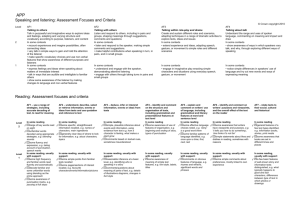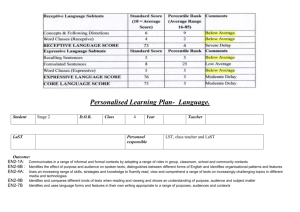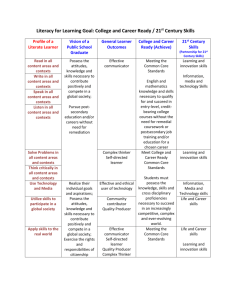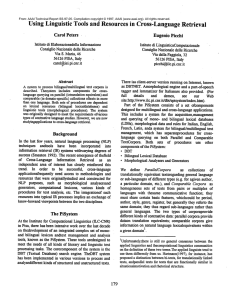ELLP Oral input april10
advertisement
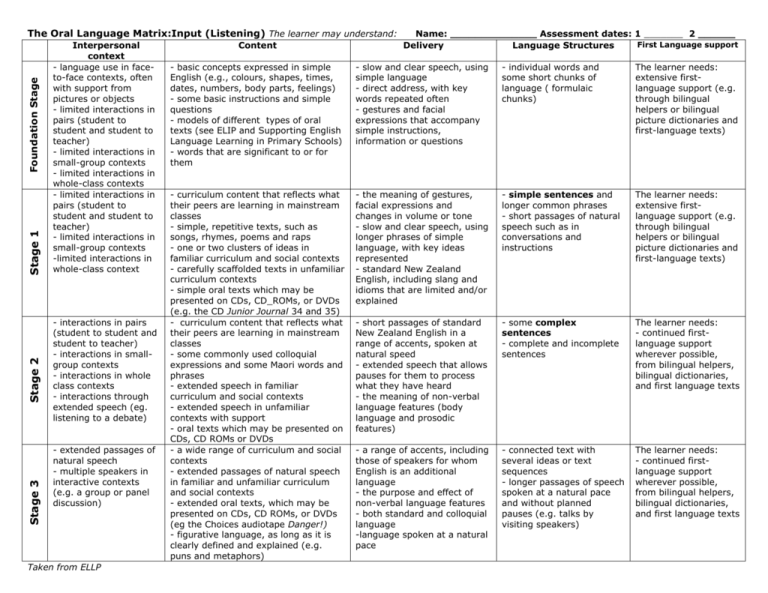
Stage 3 Stage 2 Stage 1 Foundation Stage The Oral Language Matrix:Input (Listening) The learner may understand: Interpersonal context - language use in faceto-face contexts, often with support from pictures or objects - limited interactions in pairs (student to student and student to teacher) - limited interactions in small-group contexts - limited interactions in whole-class contexts - limited interactions in pairs (student to student and student to teacher) - limited interactions in small-group contexts -limited interactions in whole-class context - interactions in pairs (student to student and student to teacher) - interactions in smallgroup contexts - interactions in whole class contexts - interactions through extended speech (eg. listening to a debate) - extended passages of natural speech - multiple speakers in interactive contexts (e.g. a group or panel discussion) Taken from ELLP Content Name: ______________ Assessment dates: 1 _______ 2 ______ First Language support Delivery Language Structures - basic concepts expressed in simple English (e.g., colours, shapes, times, dates, numbers, body parts, feelings) - some basic instructions and simple questions - models of different types of oral texts (see ELIP and Supporting English Language Learning in Primary Schools) - words that are significant to or for them - slow and clear speech, using simple language - direct address, with key words repeated often - gestures and facial expressions that accompany simple instructions, information or questions - individual words and some short chunks of language ( formulaic chunks) The learner needs: extensive firstlanguage support (e.g. through bilingual helpers or bilingual picture dictionaries and first-language texts) - curriculum content that reflects what their peers are learning in mainstream classes - simple, repetitive texts, such as songs, rhymes, poems and raps - one or two clusters of ideas in familiar curriculum and social contexts - carefully scaffolded texts in unfamiliar curriculum contexts - simple oral texts which may be presented on CDs, CD_ROMs, or DVDs (e.g. the CD Junior Journal 34 and 35) - curriculum content that reflects what their peers are learning in mainstream classes - some commonly used colloquial expressions and some Maori words and phrases - extended speech in familiar curriculum and social contexts - extended speech in unfamiliar contexts with support - oral texts which may be presented on CDs, CD ROMs or DVDs - a wide range of curriculum and social contexts - extended passages of natural speech in familiar and unfamiliar curriculum and social contexts - extended oral texts, which may be presented on CDs, CD ROMs, or DVDs (eg the Choices audiotape Danger!) - figurative language, as long as it is clearly defined and explained (e.g. puns and metaphors) - the meaning of gestures, facial expressions and changes in volume or tone - slow and clear speech, using longer phrases of simple language, with key ideas represented - standard New Zealand English, including slang and idioms that are limited and/or explained - simple sentences and longer common phrases - short passages of natural speech such as in conversations and instructions The learner needs: extensive firstlanguage support (e.g. through bilingual helpers or bilingual picture dictionaries and first-language texts) - short passages of standard New Zealand English in a range of accents, spoken at natural speed - extended speech that allows pauses for them to process what they have heard - the meaning of non-verbal language features (body language and prosodic features) - some complex sentences - complete and incomplete sentences The learner needs: - continued firstlanguage support wherever possible, from bilingual helpers, bilingual dictionaries, and first language texts - a range of accents, including those of speakers for whom English is an additional language - the purpose and effect of non-verbal language features - both standard and colloquial language -language spoken at a natural pace - connected text with several ideas or text sequences - longer passages of speech spoken at a natural pace and without planned pauses (e.g. talks by visiting speakers) The learner needs: - continued firstlanguage support wherever possible, from bilingual helpers, bilingual dictionaries, and first language texts


